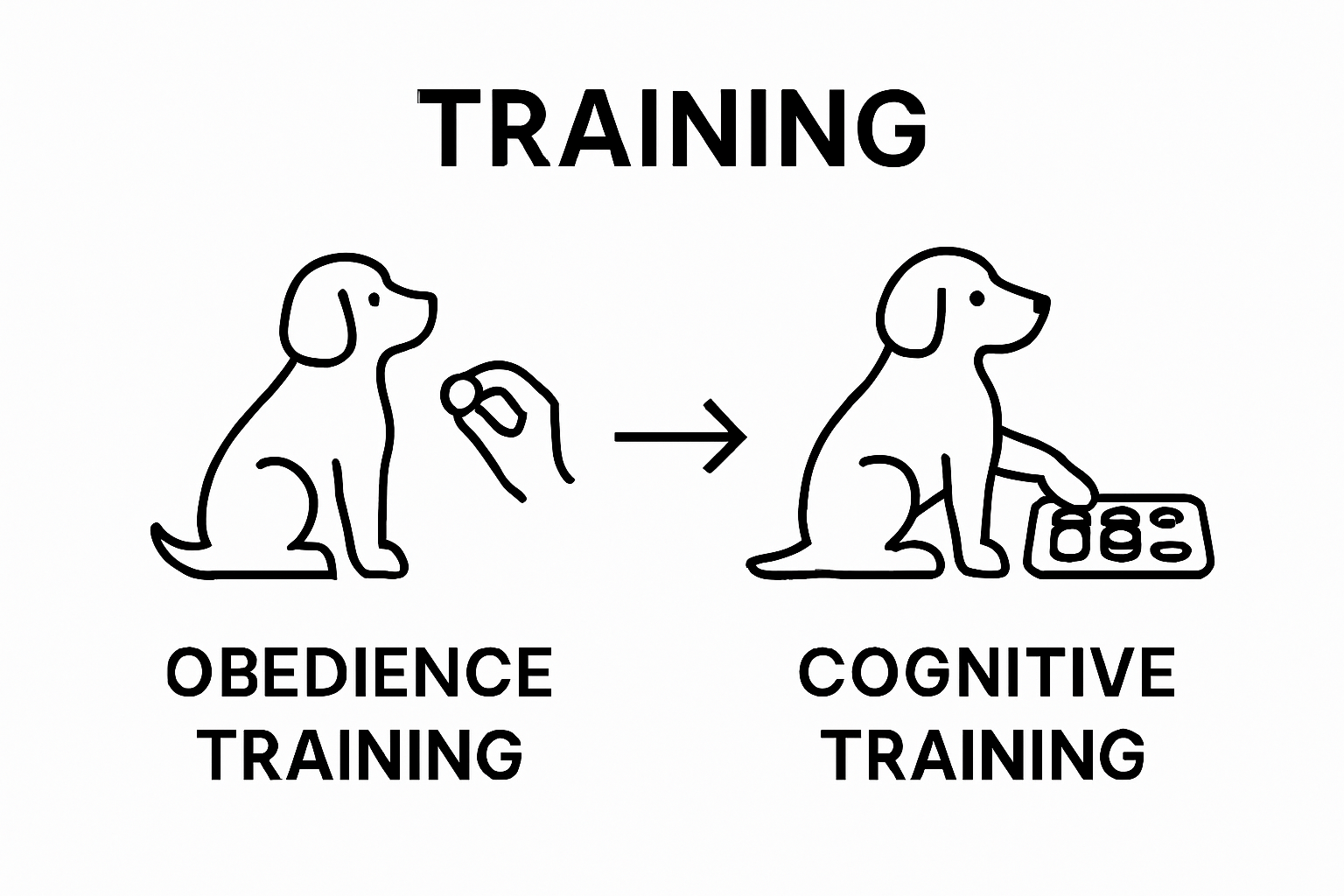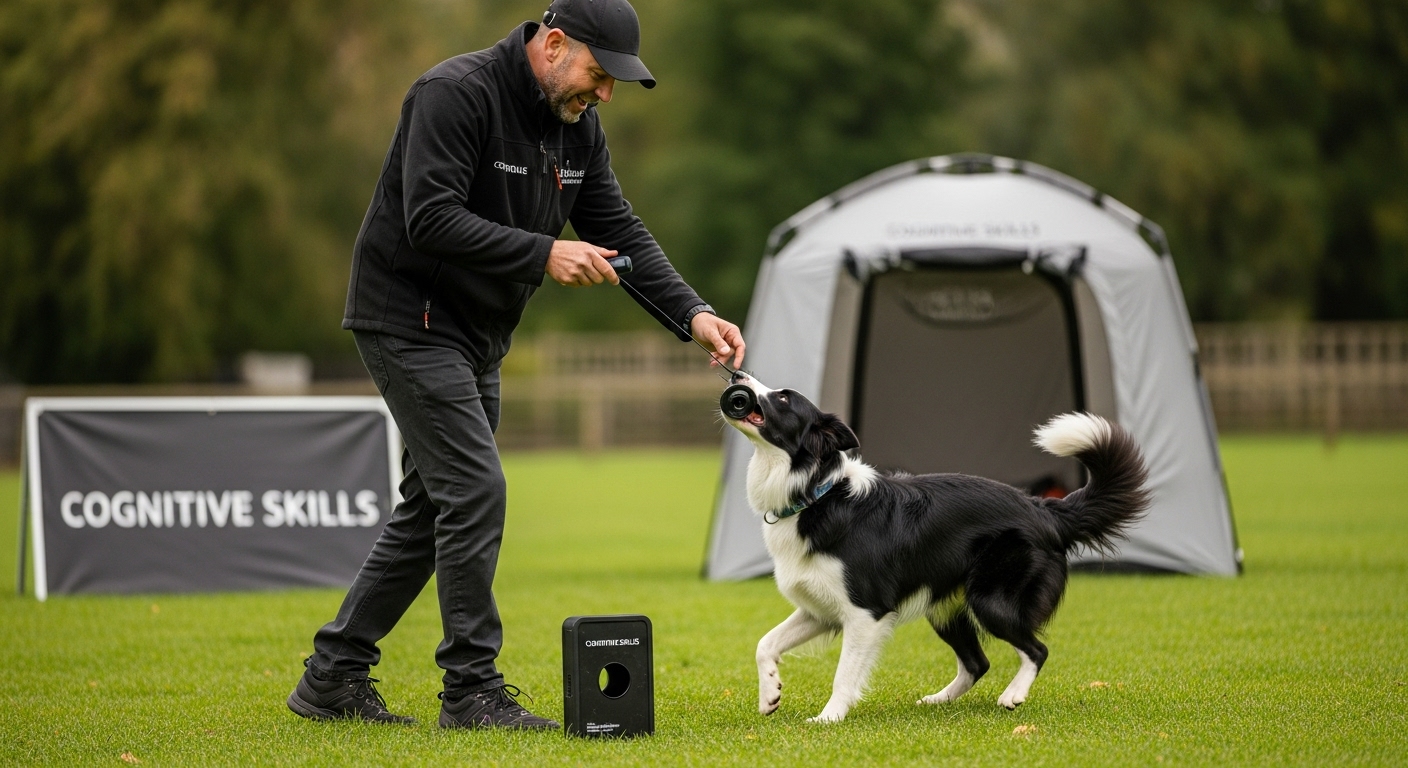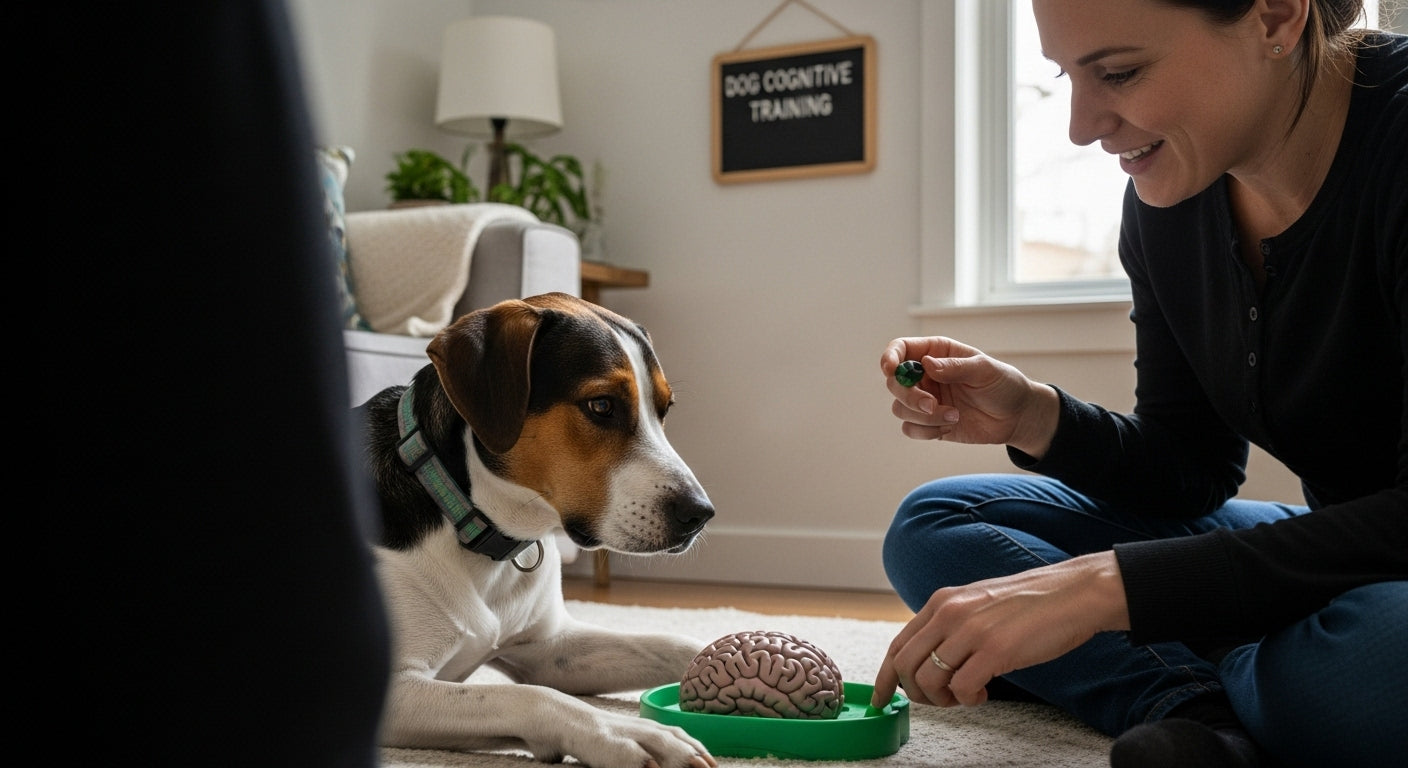Dog cognitive training is catching attention for all the right reasons. Studies reveal that regular mental challenges can prevent cognitive decline in older dogs and boost their emotional resilience. Yet most people think training is just about sit, stay, and fetch. The real surprise is how these mental workouts can change your dog’s brain, helping them become smarter and happier beyond anything basic obedience offers.
Table of Contents
- What Is Dog Cognitive Training And Its Importance?
- The Science Behind Dog Cognition And Learning
- Benefits Of Dog Cognitive Training For All Dogs
- Key Concepts And Techniques In Dog Cognitive Training
- Real-World Applications Of Dog Cognitive Training
Quick Summary
| Takeaway | Explanation |
|---|---|
| Cognitive training enhances mental stimulation | It goes beyond basic obedience, promoting advanced problem-solving and critical thinking in dogs. |
| Regular mental exercise prevents cognitive decline | Engaging older dogs in cognitive activities can slow age-related mental deterioration and reduce anxiety. |
| Positive reinforcement is key in training | Rewarding desired behaviors encourages deeper engagement and reinforces learning in dogs. |
| Cognitive training improves emotional health | Structured mental challenges lead to better emotional regulation and lower stress levels in dogs. |
| Tailor training to individual dog needs | Understanding each dog’s personality allows for customized approaches that maximize their cognitive potential. |
What is Dog Cognitive Training and Its Importance?
Dog cognitive training represents a sophisticated approach to mental stimulation and learning that goes beyond traditional obedience training. This specialized method focuses on enhancing a dog’s mental capabilities, problem-solving skills, and overall cognitive function. Learn how dogs develop cognitive skills reveals that cognitive training is more than just teaching tricks - it’s about developing a dog’s intellectual potential.
Understanding Cognitive Training Fundamentals
Cognitive training involves structured mental exercises designed to challenge and improve a dog’s brain function. These activities are carefully crafted to stimulate neural connections, enhance memory, and develop complex thinking patterns. Unlike basic command training, cognitive training requires dogs to analyze situations, make decisions, and solve problems independently.

Key aspects of cognitive training include:
- Puzzle-solving activities
- Memory-based challenges
- Problem-solving games
- Interactive learning scenarios
The Critical Role of Mental Stimulation
Mental stimulation is as crucial for dogs as physical exercise. Cognitive training helps prevent cognitive decline, particularly in older dogs, by keeping their minds active and engaged. Regular mental challenges can slow down age-related cognitive dysfunction, reduce anxiety, and improve overall behavioral health.
For dogs, mental exercise is not a luxury but a necessity. Just like humans, dogs require continuous learning and intellectual engagement to maintain optimal cognitive function. Read more about dog training techniques to understand how structured mental activities can transform your pet’s cognitive abilities.
By investing time in cognitive training, dog owners can help their pets develop sharper minds, better emotional regulation, and more robust problem-solving skills. This approach transforms training from a simple command-response interaction into a meaningful, enriching experience that strengthens the bond between dogs and their human companions.
The Science Behind Dog Cognition and Learning
Dog cognition represents a fascinating field of scientific research that explores how canines perceive, process, and interact with their environment. Research from Frontiers in Veterinary Science reveals that dogs possess remarkable cognitive abilities that extend far beyond simple stimulus-response mechanisms, demonstrating complex mental processes comparable to young human children.
Neurological Foundations of Canine Learning
The canine brain contains approximately 530 million neurons, enabling sophisticated cognitive functions. Dogs learn through multiple interconnected processes, including associative learning, social learning, and observational comprehension. These neurological pathways allow dogs to understand complex commands, recognize emotional cues, and adapt their behavior based on environmental interactions.
To clarify the key neurological learning mechanisms mentioned, here is a table summarizing each process and its function in canine cognition.
| Neurological Mechanism | Description |
|---|---|
| Classical conditioning | Learning through associations between two stimuli, leading to automatic behavioral responses. |
| Operant conditioning | Learning based on the consequences of behavior, utilizing rewards or punishments. |
| Social referencing | Understanding and mimicking behaviors by observing others within social contexts. |
| Episodic memory formation | Remembering specific events, experiences, or interactions for future reference. |
| Spatial reasoning | Navigating and understanding physical environments and locations. |
Key neurological learning mechanisms include:
- Classical conditioning
- Operant conditioning
- Social referencing
- Episodic memory formation
- Spatial reasoning
Comparative Cognitive Research
Modern scientific studies demonstrate that dogs possess impressive cognitive capabilities. They can understand human gestures, interpret emotional signals, and solve complex problems. Explore advanced dog training strategies to leverage these remarkable cognitive skills effectively.
Researchers have discovered that dogs develop cognitive skills through continuous mental stimulation, social interactions, and structured learning experiences. Their ability to learn goes beyond basic obedience, encompassing nuanced understanding of social dynamics, emotional intelligence, and adaptive problem-solving strategies.
Understanding the science behind dog cognition helps owners create more effective, engaging, and meaningful training approaches that respect the complexity of their pet’s mental capabilities.
Here is a table comparing traditional obedience training and cognitive training, highlighting their focus, methods, and outcomes for dogs.
| Aspect | Traditional Obedience Training | Cognitive Training |
|---|---|---|
| Primary Focus | Teaching basic commands and routines | Enhancing mental capabilities and problem-solving |
| Training Methods | Repetition of set behaviors | Puzzles, games, and decision-making tasks |
| Nature of Engagement | Command-response | Independent thinking and exploration |
| Behavioral Outcomes | Reliable obedience, routine behaviors | Improved adaptability, emotional resilience |
| Long-Term Cognitive Impact | Limited | Potential cognitive growth and enrichment |
Benefits of Dog Cognitive Training for All Dogs
Dog cognitive training offers remarkable advantages that extend far beyond traditional obedience methods. Research from scientific studies demonstrates that structured mental exercises can significantly enhance a dog’s overall quality of life, regardless of breed, age, or background.
Mental Health and Behavioral Improvements
Cognitive training serves as a powerful tool for psychological well-being, helping dogs develop emotional resilience and reduce anxiety. Dogs engaged in regular mental stimulation exhibit lower stress levels, improved impulse control, and more balanced behavioral patterns. These mental exercises challenge dogs to think critically, adapt to new situations, and develop stronger problem-solving skills.
Key behavioral benefits include:
- Reduced destructive behaviors
- Enhanced emotional regulation
- Increased confidence
- Better stress management
- Improved social interactions
Physical and Neurological Advantages
Beyond mental benefits, cognitive training provides significant neurological advantages. Regular mental exercises help maintain cognitive function, particularly in aging dogs, potentially slowing cognitive decline and preventing age-related mental deterioration. Learn more about advanced training strategies to support your dog’s long-term cognitive health.
Cognitive training stimulates neural connections, promotes brain plasticity, and encourages continuous learning.
 Dogs that receive consistent mental challenges demonstrate improved memory retention, faster learning capabilities, and greater adaptability in various environments.
Dogs that receive consistent mental challenges demonstrate improved memory retention, faster learning capabilities, and greater adaptability in various environments.
By investing time in cognitive training, dog owners can help their pets develop sharper minds, more robust problem-solving skills, and a deeper, more meaningful connection with their human companions.
Key Concepts and Techniques in Dog Cognitive Training
Research from the National Institutes of Health reveals that dog cognitive training involves sophisticated techniques designed to challenge and enhance canine mental capabilities. Understanding these core principles enables dog owners to create effective, engaging learning experiences that go beyond traditional training methods.
Core Training Principles
Positive reinforcement forms the foundation of effective cognitive training. This approach focuses on rewarding desired behaviors rather than punishing unwanted actions. Dogs learn most effectively when they associate mental challenges with positive outcomes, which motivates them to engage more deeply with training exercises.
Key cognitive training principles include:
- Incremental difficulty progression
- Consistent reward systems
- Short, focused training sessions
- Varied stimulation techniques
- Individual learning pace adaptation
Advanced Cognitive Training Methods
Cognitive training encompasses a range of sophisticated techniques designed to stimulate mental processes. These methods challenge dogs to think critically, solve problems, and develop complex reasoning skills. Explore advanced training strategies to understand how to implement these techniques effectively.
Techniques like shaping, where dogs are gradually guided toward more complex behaviors through successive approximations, allow for nuanced mental development.
Environmental enrichment plays a crucial role, introducing varied stimuli that encourage dogs to explore, analyze, and adapt to new scenarios.
Successful cognitive training requires patience, consistency, and a deep understanding of individual dog personalities. By recognizing each dog’s unique learning style, owners can create tailored training approaches that maximize mental potential and strengthen the human-canine bond.
Real-World Applications of Dog Cognitive Training
Research from Frontiers in Veterinary Science demonstrates that dog cognitive training extends far beyond simple academic exercises, offering transformative benefits across multiple professional and personal domains. These practical applications showcase the remarkable potential of structured mental stimulation for canines.
Service and Assistance Dog Development
Cognitive training plays a critical role in preparing service dogs for complex working environments. These highly trained animals must navigate intricate social scenarios, make independent decisions, and respond to subtle human cues. Through targeted cognitive exercises, dogs develop advanced problem-solving skills, emotional intelligence, and adaptive capabilities essential for supporting individuals with disabilities.
Key service dog cognitive training focus areas include:
- Medical alert capabilities
- Navigation and spatial awareness
- Emotional regulation
- Complex task interpretation
- Independent decision making
Behavioral Rehabilitation and Shelter Environments
Cognitive training provides powerful interventions for dogs experiencing behavioral challenges or transitioning through shelter systems. Explore advanced training techniques to understand how mental stimulation can transform challenging behavioral patterns.
Structured cognitive exercises help rehabilitate dogs with anxiety, aggression, or socialization difficulties. By engaging these animals in mentally stimulating activities, trainers can rebuild confidence, reduce stress, and create pathways for more positive interactions. Shelters utilizing cognitive training approaches report improved adoption rates and more successful long-term placements for challenging dogs.
These real-world applications underscore cognitive training’s transformative potential, demonstrating that mental stimulation is not a luxury but a fundamental component of comprehensive canine care and development.
Strengthen Your Dog’s Mind With Real-World Cognitive Training Tools
Are you looking for an easier way to reinforce your dog’s problem-solving skills and communication abilities at home? The article highlights how essential cognitive training is for mental stimulation, emotional regulation, and building a strong pet-human bond. You want your dog to have sharper focus, reduced anxiety, and the confidence to adapt to new situations. Traditional training often falls short when it comes to teaching dogs how to communicate their needs independently. That is where modern, interactive solutions make the difference. With a purpose-built communication device, you can level up the skills discussed in this article and see proven results in your daily routine.

Empower your pet to express their needs clearly and safely with the iPupPee alert device, designed to support everything from cognitive development to greater independence for both dogs and owners. Visit ipuppee.com to discover the full benefits, browse easy training guides, and see real customer transformations. Your dog’s journey to a smarter, more confident life starts today. Take action now and experience the next step in pet communication.
Frequently Asked Questions
What is dog cognitive training?
Dog cognitive training is a specialized approach that enhances a dog’s mental capabilities through structured exercises and activities. It focuses on improving problem-solving skills, memory, and overall cognitive function, going beyond traditional obedience methods.
Why is mental stimulation important for dogs?
Mental stimulation is vital for dogs as it helps prevent cognitive decline, reduces anxiety, and improves overall behavioral health. Engaging in regular cognitive activities keeps dogs mentally active, which is essential for their well-being and happiness.
What are some techniques used in dog cognitive training?
Techniques in dog cognitive training include puzzle-solving activities, memory-based challenges, problem-solving games, and interactive learning scenarios. These methods encourage dogs to think critically and develop complex reasoning skills.
How can I start cognitive training with my dog?
You can start cognitive training by incorporating short, focused sessions that include positive reinforcement. Begin with simple mental challenges, gradually increasing the difficulty as your dog becomes more adept. Always tailor the activities to your dog’s individual learning pace and preferences.
Recommended
- Proven Training Techniques for Dogs: Guide for Owners & Handlers 2025 – iPupPee
- Smart Dog Training Tips for Every Owner: 2025 Guide – iPupPee
- How Dogs Learn: Simple Science for Smarter Training in 2025 – iPupPee
- Top Benefits of Dog Training for All Pet Owners in 2025 – iPupPee
- Understanding the Various Types of Dog Collars

